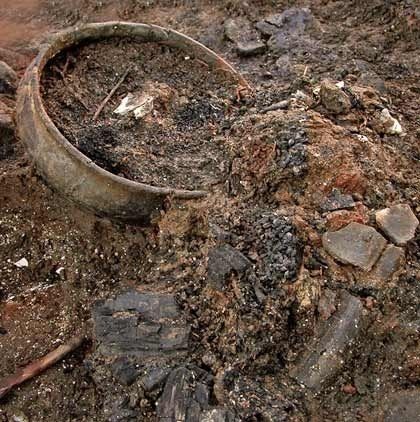Post by UKarchaeology on Jul 19, 2015 18:09:34 GMT

Archaeologists say Bronze Age residents may have abandoned site after fire, compare discoveries to Mary Rose
An “extraordinary testimony” to the lives of prosperous people in Bronze Age Britain could lie under the soil of a 1,100-square metre site destroyed in a fire 3,000 years ago, say archaeologists who are about to start digging within a brick pit near Peterborough.
Must Farm – part of the Flag Fen Basin, and the site where nine pristine log boats were famously unearthed in 2011 – was protected by a ring of wooden posts before a dramatic fire at the end of the Bronze Age caused the dwelling to collapse into the river.
Its submergence preserved its contents, creating what experts are describing as a “time capsule” of “exceptional” decorated tiles made from lime tree bark.
Rare small pots, jars complete with the remains of hastily-abandoned meals and “sophisticated” exotic glass beads are expected to provide a complete picture of prehistoric life during the nine-month excavation, which is part of a four-year, £1.1 million project at the site.
“We think those living in the settlement were forced to leave everything behind when it caught on fire,” says Kasia Gdaniec, Cambridgeshire County Council’s Senior Archaeologist.
“An extraordinarily rich range of goods and objects are present in the river deposits, some of which were found during an evaluation in 2006.
“Among the items was a charred pot with vitrified food inside it and a partially charred spoon, suggesting that the site had been abandoned quickly.
“We anticipate that more of the timber structure, a range of organic remains and fishing equipment and the whole gamut of personal, work and settlement paraphernalia will be found.
“But we are hoping not to find remains of people that may have suffered the impact of the fire, though this possibility cannot be ruled out.
“It’s an exciting excavation. The finds are well preserved due to the waterlogged sediments within this former river channel.”
The footprints of the settlement’s former residents still stand, although more discoveries are not expected to emerge until late summer.
“Usually at a Later Bronze Age period site you get pits, post-holes and maybe one or two really exciting metal finds,” says David Gibson, the Archaeological Manager at the Cambridge Archaeological Unit.
“Convincing people that such places were once thriving settlements takes some imagination. But this time so much more has been preserved.
“It’s a fantastic chance to find out how people in the Late Bronze Age lived their daily lives, including how they dressed and what meals they ate.”
The location of the site, at the edge of the quarry, meant attempts to preserve it in situ after it was discovered in 2006 proved unviable as a long-term historic record.
“The combination of sudden abandonment followed by exceptional preservation means that there is a real possibility of further exciting discoveries,” says Duncan Wilson, of Historic England.
“This could represent a moment of time from the Late Bronze Age comparable to the connection with the past made by the objects found with the Mary Rose.
“This site is internationally important and gives a fascinating insight into the lives of our ancestors.”
A rapier and sword were found at the clay quarry, now run by a building company, in 1969. The new discoveries will be displayed at Peterborough Museum and other local venues.
Visit mustfarm.com/archaeology for more.
(soure/more pics at: www.culture24.org.uk/history-and-heritage/archaeology/art530383-archaeologists-find-bronze-age-food-at-prehistoric-settlement-comparable-to-the-mary-rose )
